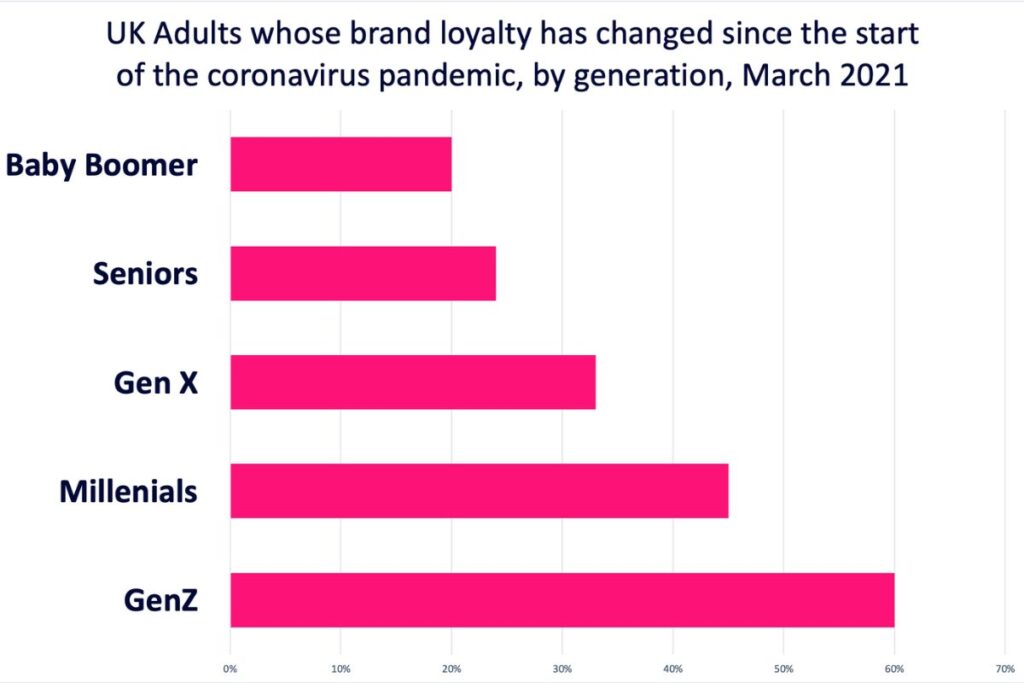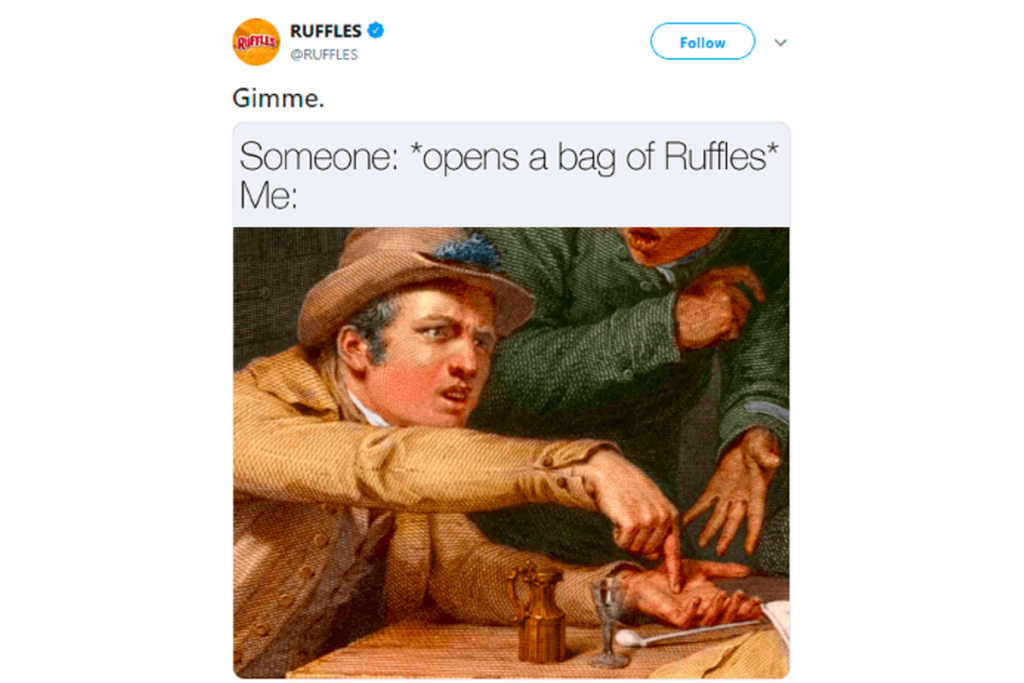Gen Zers and millennials are diverse, educated, and tech-savvy. Birthed in an era when technology has seeped into every facet of our lives, they are connected and engaged with the wider world more than any of their predecessors. Their values and principles are centred upon culture, diversity and addressing real-world issues.
E-commerce has seen a boom in recent years, with Gen Z becoming the world’s first truly digital native generation. The power to sway consumers is ever-present and, if harnessed correctly, could result in a great business opportunity.
But how does this generational sea change in technology, culture, and society impact brands and their marketing strategies? Read our blog below to find out the things brands must consider and what tactics they should adopt when developing a brand strategy to grab the attention of Gen Z and millennials alike.
The importance of evolving your brand
Simply put, brands that fail to innovate and reinvent themselves are often left behind due to their ineptitude to adapt and evolve. Think about Kodak, a hugely successful photography brand that was arguably responsible for the birth of the digital camera. As technology advanced, a huge change occurred within the photography industry with the rise in the popularity of digital photography. Kodak was firm in its stance and did not alter its brand strategy, failing to embrace the growing phenomenon of the digital world.
And so, in 2012, Kodak filed for bankruptcy – the company was history! Had they innovated earlier and adapted their brand strategy to be more inclusive of newer technologies and generational change, things may have been much different. But stand still, and you risk being overtaken!
Your marketing strategy should always be adaptable and inclusive in order to build cohesion, trust and loyalty as a cornerstone of your brand and its success. Adapting to new advancements in technology will evolve your brand, helping to accommodate and attract younger generations.
Embracing change will make your brand more receptive to Gen Zers and millennials, helping to tighten the sense of brand loyalty between them and your brand. Adopting a flexible and inclusive approach is a must!
The difficulty of establishing brand loyalty
Essentially, brand loyalty is one of the most prominent starting points for any brand strategy. But the difficulties brands face in doing so in today’s digital era means this isn’t straightforward. Gaining reliability and trust through how you present your brand is crucial, but maintaining a strong brand message to keep Gen Zers and millennials captivated is arguably the biggest challenge.
The market is currently saturated with more brands than ever before, jostling for the attention of younger audiences through quirky and captivating marketing campaigns. Brands are rightfully doing this, as it is suggested that 54% of Gen Zers will shop entirely online over the next decade.
So, there are many factors to consider, not least the level of competition from other brands which makes standing out from the crowd much more difficult. The amount of exposure today’s generations face within the digital sphere is untold, so you must consider how your brand strategy will factor in the competition and cut through to your desired target audience.
Aside from increased exposure, shopping habits shifted dramatically with a reliance on online and digital shopping channels increasing. The sustained periods of time spent indoors resulted in an increased propensity of Gen Zers and millennials to switch brands. In March 2021, 60% of Gen Z’s and 45% of millennials in the UK said they had changed their brand loyalty since the start of the pandemic.

Aside from circumstances arising as a result of the pandemic, other external factors contribute significantly to behavioural changes seen by the consumers of today. Unlike previous generations, online shopping has been a mainstay in the lives of Gen Z and millennials. Whereas boomers and older generations have had to adapt to mass change in technology and subsequently people’s shopping habits, Gen Zers and millennials are accustomed to online shopping and its constant evolution.
The online market has grown exponentially and consumers have a plethora of options for any products or service they wish to have. Therefore, it is no surprise to learn that brand loyalty has diminished, as consumers are easily targeted and swayed by different brands, all vying and competing for that precious customer attention.
To summarise, in the face of adversity and an ultra-competitive market, staying ahead of the curve is essential. Ensure your brand strategy is digitally accessible and the core messages of your campaign are communicated across all your key social channels. By implementing this, you will maximise your chances of appealing to Gen Zers and millennials and help to enhance that all-important brand loyalty.
How authenticity helps build brand loyalty for Gen Zers
So, with an inordinate amount of market competition, how can you best connect with Gen Zers and millennials? Well, incorporating authenticity into your brand strategy would be a great starting point!
In particular, Gen Zers are supremely aware of themselves, the wider world and what they and their generation represent. Gen Zers do not hide their feelings and views, and this shapes much of the online discourse. Therefore, having a brand that recognises authenticity is of equal importance, and marketers must be aware of this when devising their strategies.
As digital natives, Gen Zers and millennials have grown up with advertising and marketing that can disguise and distort every perceived imperfection. Whether an ad is showing an unrealistic body standard or a suspiciously perfect life, tech-savvy Gen Zers and millennials can see through this, so brands must adapt and change tack.
Consumer attitudes of Gen Zers and millennials
From a consumerist standpoint, Gen Zers are the first generation to really influence the zeitgeist around marketing and brand experience. The days of brands steering marketing strategy conversations without any outside influence are no more! Instead, brands are now recognising how important it is to capture the attention of Gen Z and millennials, and how beneficial it is for their overall brand strategy.
At the nucleus of this change in approach is the strive for societal change that embodies many of the causes Gen Zers and millennials care about. There is way more than just entertainment, food and fashion that drives these groups. Social, political and environmental causes can form a great opportunity for cross-promotion with organisations that support these causes.
Brands can participate voluntarily and introduce themselves to the new generations of consumers in accordance with personal preferences or support for social causes that resonate with the target audience. However, it is a fine line for brands to navigate – if brands make claims that Gen Zers or millennials disregard as reflecting their attitudes and personal preferences, they could stand to lose out and alienate a core of young people.
Despite behaviours to brand loyalty changing, there is a strong proportion of Gen Zers that acknowledge feeling loyal to a brand is something which grows substantially as they start to figure out what they like and who they are.
Visual and interactive content

As smartphones are now owned by over 80% of adults in the UK, and 100% of Gen Zers use mobile phones, creating a stream of relatable and engaging content for use on smartphones and apps is a no-brainer if you want your brand to remain relevant to this target audience.
Inviting Gen Z and millennials to engage through interactive content to tap, click or swipe will generate a much higher percentage of interaction with your content and increase exposure for your brand. If your goal is to have a set number of interactions with your content, polls and stickers on Instagram for example, will encourage users to interact with your content and strengthen the presence of your brand on social media.
Creating content is relatively simple, but is it really enough to drive the engagement that you want from your desired target audience? The short answer is no, but with a little informative insight on areas to target, you’ll know exactly what types of visual and interactive content you should focus your efforts on to build your brand’s connection.
Social media
Social media is the most obvious starting point for any visual assets you want to create – so focusing efforts on optimising video content for Instagram, TikTok and Snapchat is an extremely effective channel to target your audience through short-form video content. In particular, Gen Z, who make up over half of the total usership of TikTok globally.
Creating engaging reels on Instagram and Tiktok, with added visual effects, music and overlays, is an invaluable tool utilised by marketers, as it allows them to showcase products and inject a dose of personality representative of their brand within their clips.
Content that is captivating that garners attention has a much higher chance of being impactful with younger audiences. As apps constantly innovate and introduce new features, brands must adapt accordingly to attract and maintain attention and foster brand loyalty.
Social media allows brands to directly communicate with consumers in a humorous way. Engagement and human interaction is a huge part of the customer experience in today’s digital age, and social media allows for a discourse that can build reliability and a fun customer experience. Viral tweets help brands connect with consumers and can provide huge exposure across the internet.
Top-of-funnel content
Aside from video content, social media presents multiple opportunities to engage and reach out to Gen Z and millennials. In order to build brand loyalty and increase sales, businesses must embrace the Gen Z – millennial tone of voice. Top-of-the-funnel content, which aims to attract and generate new leads, is a big winner for marketers looking to break through and reach those audiences.
As they are not typically looking for your brand at that moment in their customer journey, consider using infographics and visuals that capture data and information. By breaking down information into digestible, bitesize chunks, you will increase the likelihood of capturing younger users at the top of the funnel and be able to communicate to them in a palatable way.
Meme marketing

Using memes as part of marketing strategies is fast becoming a common approach for many brands. They are extremely cheap to create and time-effective, and memes are embedded within the culture of both Gen Zers and millennials. The frenetic pace of the internet can be hard to keep up with, and brands may risk looking ‘out of touch’ if a meme is used and not received well, as it may be outdated. Keep your finger on the pulse with viral trends and the latest memes on social media to avoid this.
Essentially, being able to distinguish your brand as funny and relatable in today’s digital age is crucial to building the trust and loyalty needed to capture Gen Z and millennials. Through devising visual content that encapsulates humour and injects personality, your brand will excel and deliver.
User-generated content
Video content is a surefire way to capture the attention of Gen Zers who love video content. Their preferences of Snapchat, TikTok and Instagram correlate with the video-heavy content showcased across these platforms.
Incorporating user-generated content through short-form videos as part of your strategy will only help boost those precious clicks and views, creating a hyperbole of engagement for your product or services. One idea you could implement is appealing to younger customers for their own content, in the form of submitting a video or photo of themselves interacting with your product. By offering to feature selected ones on your Instagram reels or Snapchat stories, you will gain a huge swathe of interaction.
The user bases of apps like Snapchat and TikTok are accustomed to short form reels and videos that tend to have a 60-second maximum duration. Consider adding music, visual effects or challenges users can interact with to make sure your user-generated content is short form, snappy and engaging.
Influencers
Influencer marketing can engage with the generations of today and help elevate your brand by building a connection between your brand and audiences. Putting influencers at the heart of your brand strategy can create great results. Gen Zers are more likely to buy products that influencers recommend, and that can serve as an invaluable way to reach Gen Zers and millennials, particularly in the online space.
Target influencers who are relevant to your business and target your audience most effectively in a voice that they will respond to. Finding the perfect influencer can result in greater brand awareness, sentiment, and sales, as we show here.
They can be a vital component of an omnichannel strategy that really develops your brand voice among Gen Z and millennial audiences.
Creative marketing campaigns with Digital Ethos
Connecting your brand with Gen Z and millennials requires creativity, innovation and inspiration. At Digital Ethos, we can tailor your brand strategy with a combination of data-driven strategies and creative flair, helping your brand connect with Gen Zers and millennials.Our dedicated creative marketing team has the knowledge and expertise, combined with creative skills and inspiration to deliver engaging and innovative campaigns that will elevate your brand. Contact us today and find out how more about our creative marketing campaigns can help connect with the generations of today.

